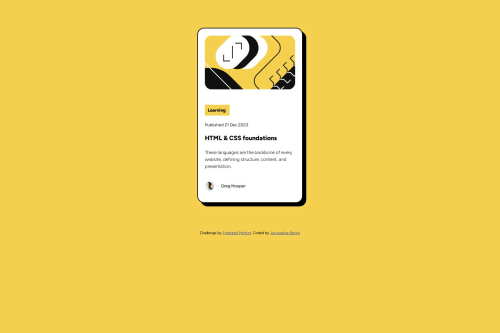Card with hover interactions

Solution retrospective
I enjoyed practicing hover and I want to learn more about focus.
What challenges did you encounter, and how did you overcome them?I had difficulty implementing focus because in my research it was only used in inputs, so I was unable to apply it to the project and I hope to understand this better in the future.
What specific areas of your project would you like help with?Please let me know if I did something wrong.
In what element can I add the focus property?
Please log in to post a comment
Log in with GitHubCommunity feedback
- @MarziaJalili
Hey there!
Some sort of suggestion:
- set the code below in the body selector to center the card:
body { display: grid; place-items: center; min-height: 100vh; }- Make sure that the card is the only child element of the
<body>.
If not wrapp everything nested inside
<body>with the<main>element. It will look something like this:<body> <main> <!-- every element nested inside --> </main> </body>Other than this your solution is spot on!
Keep up the grind🫡
- P@makogeboris
Great work, some suggestions
- All content should be wrapped within landmarks. Wrap a
maintag around the .card and afooterfor the .attribution - Change the
widthof the .card tomax-widthand should be defined inrem - It's best practice linking Google fonts directly in the HTML
headsection rather than directly in your CSS file as it enables asynchronous downloading, improving page load times. - Consider using a modern CSS reset at the start of the styles in every project. Like this one Modern CSS Reset. This will help reset a list of default browser styles.
- Font-sizes should be defined in
rem
Hope this helps, Good luck!
- All content should be wrapped within landmarks. Wrap a
- P@SerhiiDer
all good mate, good job
Join our Discord community
Join thousands of Frontend Mentor community members taking the challenges, sharing resources, helping each other, and chatting about all things front-end!
Join our Discord